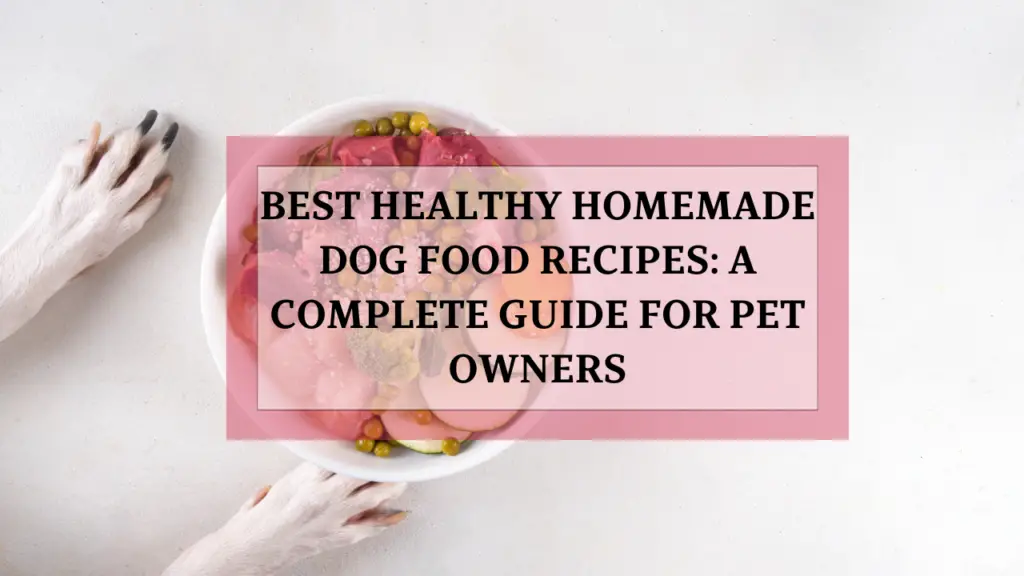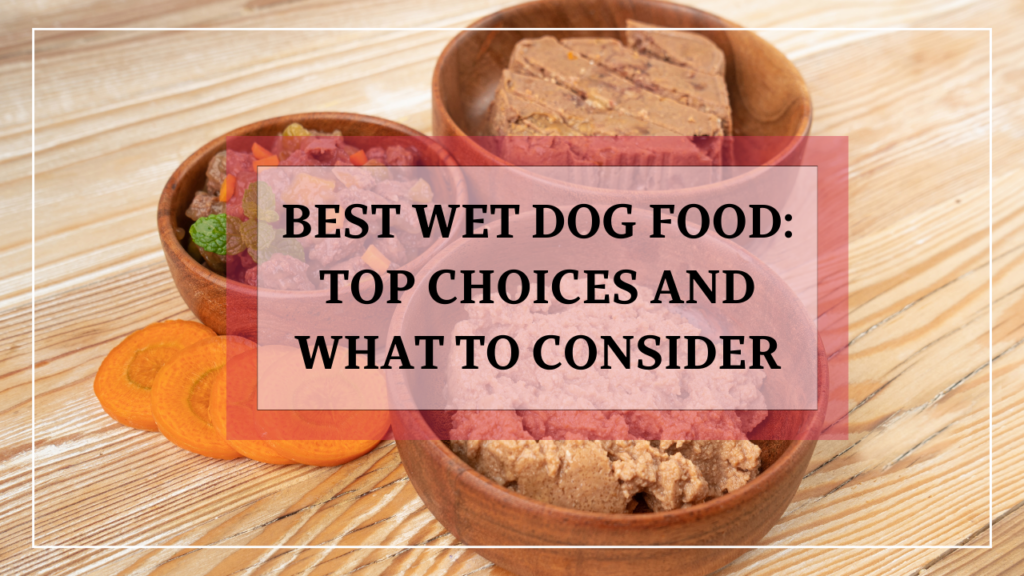Making your dog’s food at home can seem like a daunting task, but it’s one of the most rewarding ways to ensure your furry companion gets the nutrition they need. Homemade dog food allows you to control the quality of ingredients, avoid harmful additives, and customize meals to suit your dog’s specific dietary needs. In this guide, we’ll explore the best healthy homemade dog food recipes and everything you need to know about creating balanced meals that promote your dog’s health and happiness.
Whether you’re looking to supplement your dog’s diet or switch completely to homemade meals, this post provides actionable insights, easy-to-follow recipes, and tips for making the transition. Let’s dive in!
Best Healthy Homemade Dog Food Recipes
Creating delicious, nutritious meals for your dog doesn’t have to be complicated. Below are some of the best healthy homemade dog food recipes that cater to various dietary needs, from general health to specific conditions like allergies or weight management.
Balanced Chicken and Rice Meal
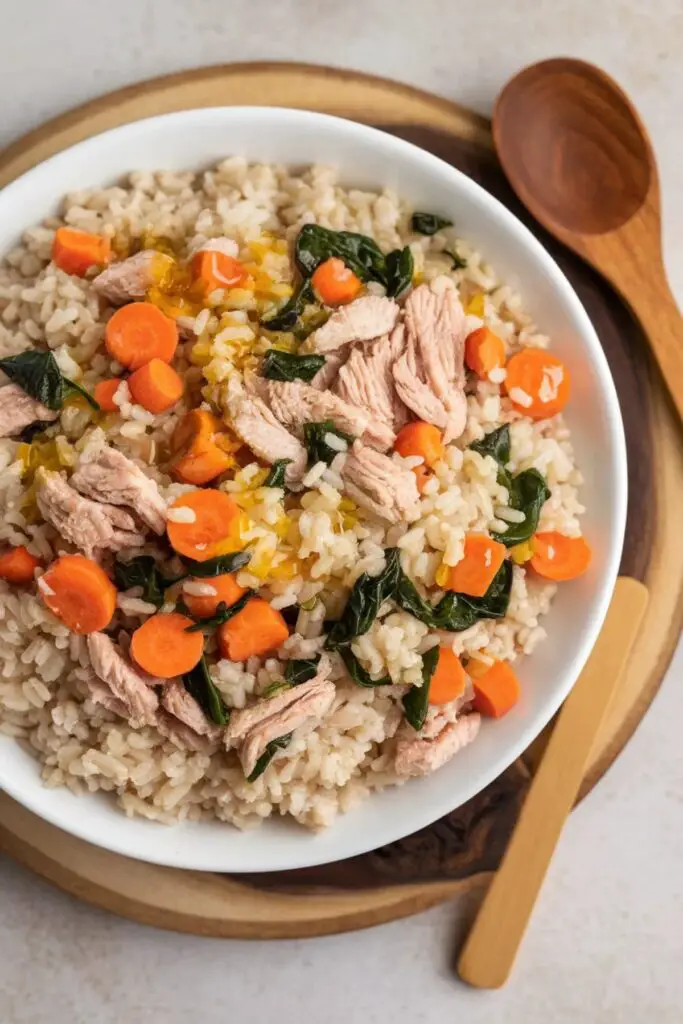
Introduction
This simple, nutritious recipe is a go-to for many dog owners. It’s easy to make and full of protein, fiber, and vitamins that contribute to overall health.
Preparation
- Preparation time: 10 minutes
- Cooking time: 20 minutes
- Servings: 4
Ingredients
- 2 cups cooked brown rice
- 1 pound ground chicken or turkey
- 1 cup chopped carrots
- 1 cup chopped spinach
- 1 tablespoon fish oil (optional)
Steps
- In a large skillet, cook the ground chicken or turkey over medium heat until fully browned.
- Add chopped carrots and cook for about 5 minutes, stirring occasionally until slightly softened.
- Stir in chopped spinach and cook for another 2 minutes until it wilts.
- In a large bowl, combine the cooked chicken mixture with the cooked brown rice and stir until evenly mixed.
- Drizzle with fish oil if using, and let the meal cool before serving.
Serving Ideas
- Serve alone as a complete meal or with a side of fresh dog-safe fruits and vegetables.
- For a bit of extra flavor, you can drizzle a small amount of unsweetened pumpkin puree over the meal.
Storage Tips
- Store in an airtight container in the fridge for up to 3 days.
- You can freeze individual servings for up to 2 months. Thaw before serving.
Give Your Dog the Ultimate Health Boost!
We highly recommend Zesty Paws Multivitamin Treats – a powerful 8-in-1 formula crafted into tasty, chicken-flavored soft chews. These premium treats deliver comprehensive support for your dog’s health by:
- Joint & Mobility: Featuring Glucosamine HCl, Chondroitin Sulfate, and OptiMSM to keep your dog moving smoothly.
- Digestive Health: A potent blend of digestive enzymes and probiotics that promotes a balanced gut.
- Skin & Coat: Enriched with Cod Liver Oil and Vitamin E to maintain a shiny coat and healthy skin.
- Overall Vitality: Packed with essential vitamins (A, C, D3) and antioxidants for immune, heart, and liver support.
Perfect for dogs of all ages and sizes, these treats are a must-have in your pet’s routine!
Turkey and Sweet Potato Stew
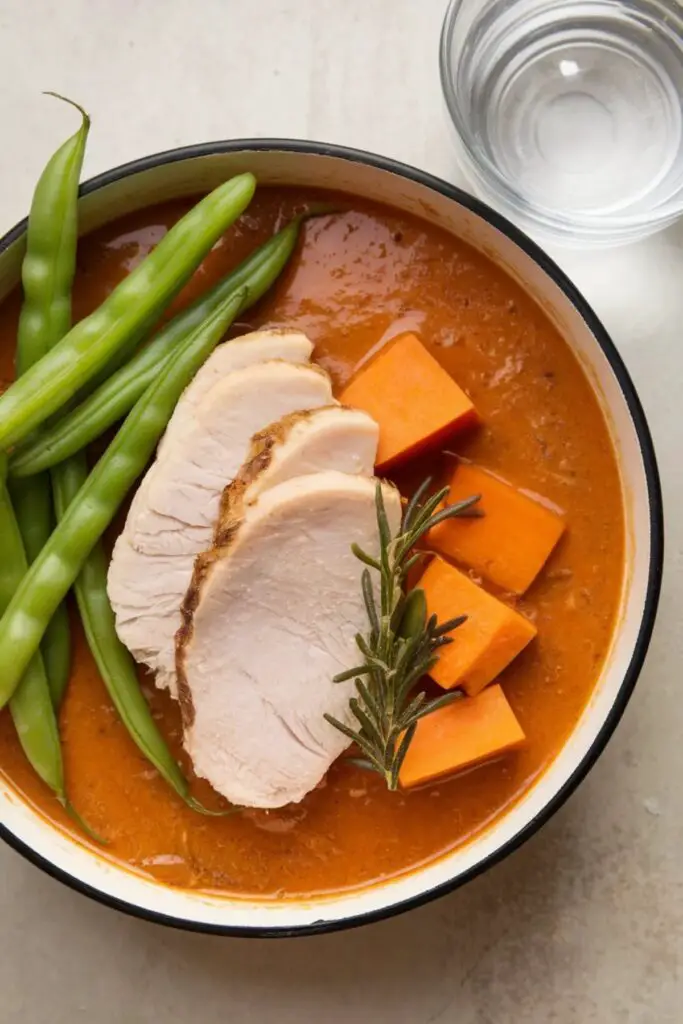
Introduction
This hearty stew is perfect for dogs who need extra energy. It’s full of complex carbs and lean protein, making it ideal for active dogs.
Preparation
- Preparation time: 10 minutes
- Cooking time: 35 minutes
- Servings: 4
Ingredients
- 1 pound ground turkey
- 2 medium sweet potatoes, peeled and diced
- 1 cup green beans, chopped
- 4 cups water or low-sodium chicken broth
Steps
- In a large pot, cook the turkey over medium heat until browned.
- Add diced sweet potatoes, green beans, and the water or chicken broth.
- Bring the mixture to a boil, then reduce the heat and let it simmer for 25-30 minutes or until the vegetables are soft and tender.
- Allow the stew to cool before serving.
Serving Ideas
- Serve as a standalone meal or mix it with your dog’s regular food for a nutritious boost.
- You can also add a small spoonful of yogurt or cottage cheese for extra protein.
Storage Tips
- Store in an airtight container in the fridge for up to 4 days.
- Freeze portions for up to 3 months. Thaw and reheat before serving.
Fish and Quinoa Delight
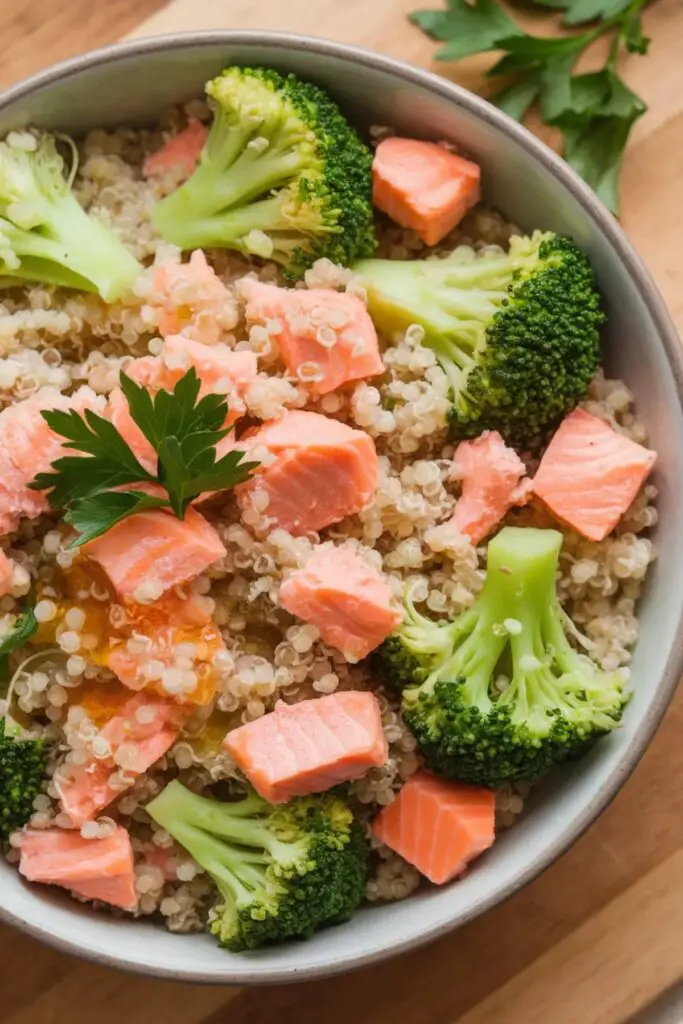
Introduction
This dish is perfect for dogs with food sensitivities and provides healthy omega-3s for a shiny coat. It’s a nutrient-packed meal for a well-balanced diet.
Preparation
- Preparation time: 10 minutes
- Cooking time: 20 minutes
- Servings: 4
Ingredients
- 2 cups cooked quinoa
- 1 pound salmon, cooked and flaked
- 1 cup steamed broccoli
- 1 tablespoon flaxseed oil
Steps
- Cook quinoa according to package instructions and set aside.
- Steam the broccoli until tender, then chop into small bite-sized pieces.
- Flake the cooked salmon into small pieces.
- In a large mixing bowl, combine the quinoa, flaked salmon, and chopped broccoli.
- Drizzle with flaxseed oil and mix thoroughly until evenly combined.
Serving Ideas
- Serve the meal on its own or mix with a bit of unsweetened, plain yogurt for added protein.
- Garnish with a few fresh dog-safe herbs like parsley for a refreshing touch.
Storage Tips
- Store leftovers in an airtight container in the fridge for up to 3 days.
- This dish can be frozen for up to 2 months. Reheat before serving.
Simple Vegetarian Dog Meal
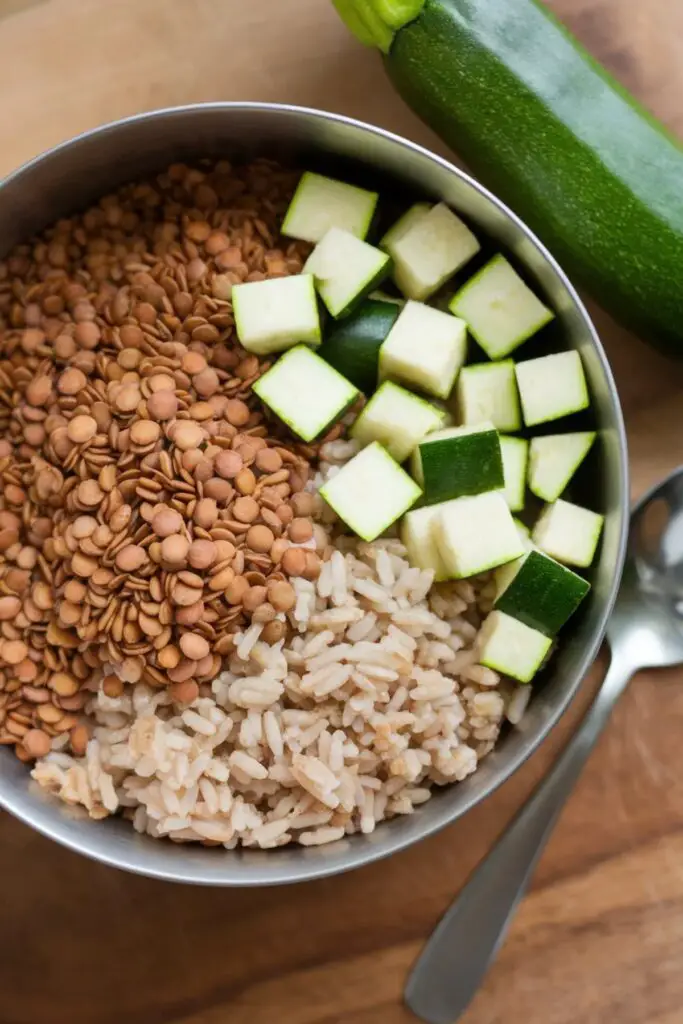
Introduction
A plant-based meal for dogs with protein sensitivities. This recipe is both satisfying and nutritious, providing plant-based protein, energy, and healthy fats.
Preparation
- Preparation time: 10 minutes
- Cooking time: 25 minutes
- Servings: 4
Ingredients
- 1 cup cooked lentils
- 1 cup cooked brown rice
- 1 cup diced zucchini
- 1 tablespoon olive oil
Steps
- Cook lentils and rice separately according to their package instructions.
- In a skillet, heat olive oil and sauté diced zucchini until soft.
- Combine cooked lentils, rice, and zucchini in a large bowl and mix thoroughly.
- Let the mixture cool to room temperature before serving.
Serving Ideas
- You can add a bit of cooked chicken or turkey if your dog needs extra protein.
- Serve alongside some fresh dog-safe vegetables like green beans for added nutrition.
Storage Tips
- Store in an airtight container in the fridge for up to 3 days.
- Freeze portions for up to 2 months. Let thaw before serving.
Beef and Vegetable Medley
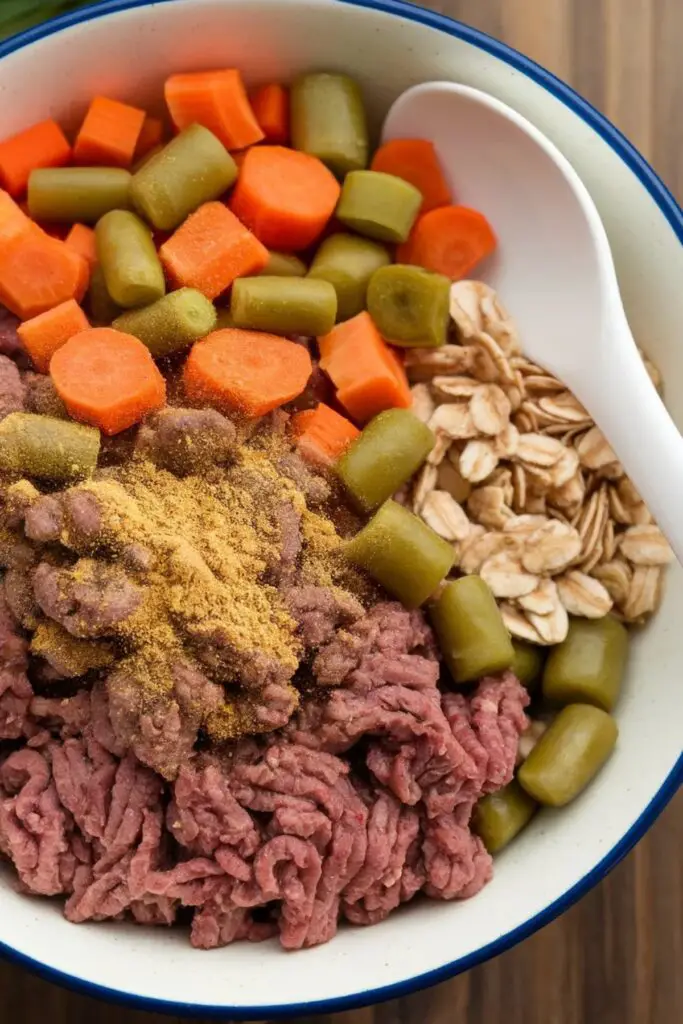
Introduction
This nutrient-packed meal is great for active dogs, offering protein, fiber, and healthy fats that will help support muscle and energy levels.
Preparation
- Preparation time: 10 minutes
- Cooking time: 30 minutes
- Servings: 4
Ingredients
- 1 pound lean ground beef
- 1 cup diced carrots
- 1 cup diced green beans
- 1 cup cooked oats
- 1 teaspoon calcium powder
Steps
- Cook the ground beef in a skillet over medium heat until browned. Drain any excess fat.
- Steam the carrots and green beans in a separate pot until tender.
- In a large mixing bowl, combine the cooked beef, vegetables, and oats.
- Add calcium powder and mix thoroughly.
- Allow the meal to cool before serving.
Serving Ideas
- Serve the meal as a standalone dish or pair it with some fruit slices like apple or blueberries.
- You can also top it with a small amount of plain yogurt for added protein and creaminess.
Storage Tips
- Store in the fridge for up to 4 days.
- This meal can be frozen for up to 3 months. Thaw before serving.
Chicken and Pumpkin Feast

Introduction
This meal is great for dogs with sensitive stomachs, as pumpkin helps with digestion. It’s also a wonderful source of fiber and lean protein.
Preparation
- Preparation time: 10 minutes
- Cooking time: 20 minutes
- Servings: 4
Ingredients
- 1 pound cooked chicken breast, shredded
- 1 cup canned pumpkin (unsweetened)
- 1 cup cooked quinoa
- 1 tablespoon coconut oil
Steps
- Shred the cooked chicken breast into bite-sized pieces.
- In a large bowl, mix the shredded chicken, pumpkin, and quinoa.
- Drizzle with coconut oil and stir until everything is evenly combined.
- Let the mixture cool to room temperature before serving.
Serving Ideas
- Serve as a standalone meal or combine it with some cooked vegetables like carrots or peas.
- You can also mix in some plain yogurt for added texture and probiotics.
Storage Tips
- Store in an airtight container in the fridge for up to 3 days.
- Freeze portions for up to 2 months and thaw before serving.
DIY Puppy Growth Formula
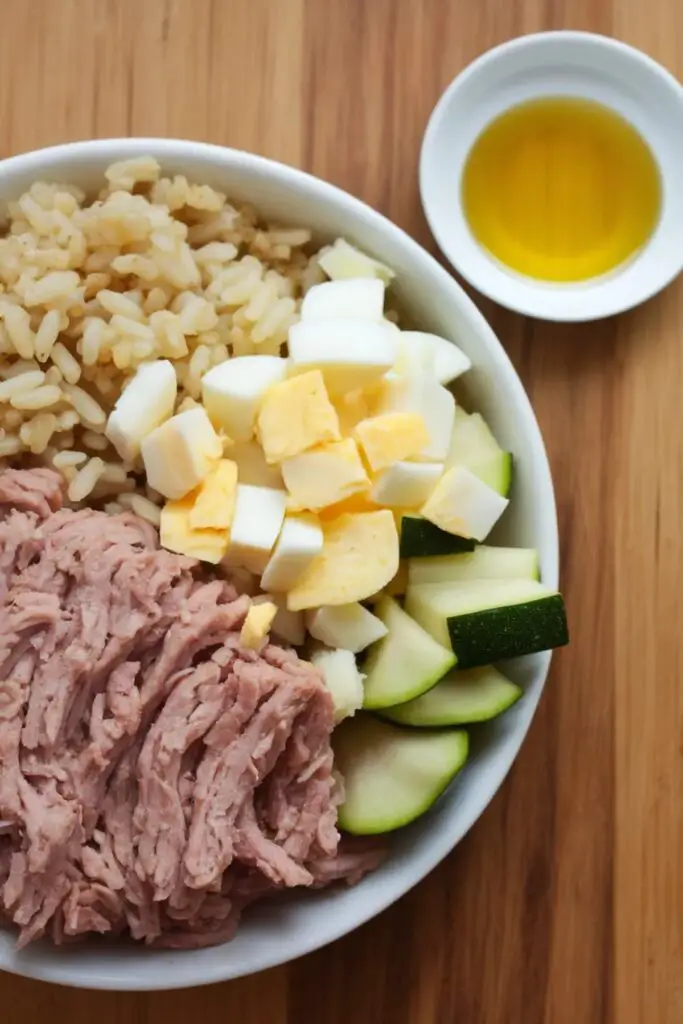
Introduction
This specially designed recipe is packed with the nutrients puppies need for growth and development. It includes calcium, protein, and vitamins for a healthy start.
Preparation
- Preparation time: 10 minutes
- Cooking time: 15 minutes
- Servings: 4
Ingredients
- 1 pound ground turkey
- 2 cups cooked brown rice
- 1 cup shredded zucchini
- 1 boiled egg, finely chopped
- 1 teaspoon fish oil
Steps
- Cook the ground turkey in a skillet over medium heat until fully cooked.
- Steam zucchini until tender, then shred it into small pieces.
- In a large bowl, combine the cooked turkey, rice, and zucchini.
- Add the chopped boiled egg and fish oil. Stir to combine.
- Let the mixture cool before serving.
Serving Ideas
- Serve the mixture as a meal on its own, or mix it with some soft dog food for additional flavor.
- You can add a spoonful of cottage cheese for extra calcium.
Storage Tips
- Store in the fridge for up to 3 days.
- This recipe can be frozen for up to 2 months. Let thaw and reheat before serving.
Grain-Free Venison and Sweet Potato Mash
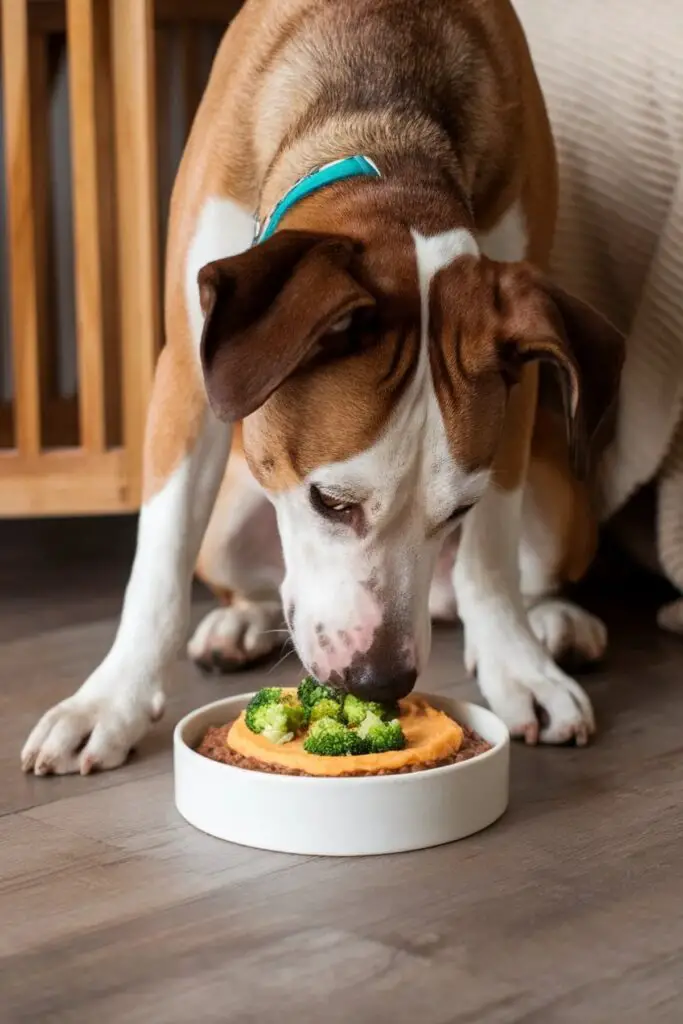
Introduction
Perfect for dogs with grain allergies, this hypoallergenic recipe combines lean venison with sweet potatoes and broccoli for a wholesome, nutrient-rich meal.
Preparation
- Preparation time: 10 minutes
- Cooking time: 30 minutes
- Servings: 4
Ingredients
- 1 pound cooked venison
- 2 medium sweet potatoes, mashed
- 1 cup steamed broccoli
- 1 tablespoon flaxseed oil
Steps
- Cook the venison thoroughly and cut it into small pieces.
- Boil sweet potatoes until soft, then mash them.
- Steam broccoli and chop it into bite-sized pieces.
- Combine venison, sweet potatoes, and broccoli in a large mixing bowl.
- Drizzle with flaxseed oil and mix until combined. Let cool before serving.
Serving Ideas
- Serve as a complete meal or add a side of fruit like blueberries for added antioxidants.
- You can also mix this with a small amount of plain yogurt for extra probiotics.
Storage Tips
- Store in the fridge for up to 4 days.
- Freeze individual portions for up to 3 months. Thaw before serving.
Keep Your Dog Thriving – Try Zesty Paws!
Boost your furry friend’s wellness with these outstanding multivitamin treats. Here’s why we recommend them:
- Joint & Hip Support: Glucosamine, Chondroitin, and OptiMSM work in harmony for optimal mobility.
- Digestive Balance: A robust digestive enzyme blend with six-strain probiotics supports gut health and normal bowel function.
- Skin & Coat Health: Cod Liver Oil, Vitamin E, and antioxidants help maintain moisture and reduce oxidative stress.
- Overall Wellness: Essential vitamins A, C, and D3 promote heart, liver, and immune health for a vibrant, active dog.
These grain-free chews are designed to fit seamlessly into your dog’s daily routine—keeping them active, healthy, and full of life!
Why Choose Healthy Homemade Dog Food?
Making the switch to homemade meals for your dog comes with several advantages that directly impact their health, happiness, and even longevity. Here’s why more pet owners are opting for healthy homemade dog food:
Benefits of Homemade Dog Food
- Control Over Ingredients
Homemade meals let you pick high-quality ingredients, avoiding fillers like corn, soy, or animal by-products often found in commercial dog foods. You know exactly what your dog is eating, which can be reassuring for any pet parent. - Improved Nutritional Balance
Tailoring your dog’s meals to their specific needs ensures they receive the right amount of protein, fats, and carbs. For instance, senior dogs might need lower calories, while active breeds require more energy-dense meals. - Freshness and Taste
Dogs appreciate fresh, flavorful food just as much as humans do! Homemade meals are more palatable, encouraging even picky eaters to clean their bowls. - Addressing Allergies and Sensitivities
Allergies to ingredients like chicken, wheat, or dairy are common. Homemade dog food allows substitutions, ensuring your pet doesn’t miss out on nutrients while avoiding allergens. - Long-Term Cost Savings
While it may seem expensive at first, homemade dog food can save money over time, especially by preventing costly health issues related to poor diet.
Common Misconceptions About Homemade Dog Food
Myth 1: It’s too time-consuming.
While making dog food does take some preparation, many recipes are quick and batch-friendly, meaning you can cook once a week and freeze portions.
Myth 2: It’s more expensive than kibble.
High-quality commercial dog food can be as costly as preparing meals at home, especially when you shop smart by buying in bulk or using seasonal produce.
Myth 3: My dog won’t get a balanced diet.
With the right recipes and guidance, you can ensure balanced nutrition. Consulting a veterinarian or canine nutritionist can help you get started.
Key Nutritional Requirements for Dogs
Understanding your dog’s nutritional needs is the foundation of creating healthy homemade dog food recipes. Let’s break down the essentials:
What Makes a Balanced Diet for Dogs?
- Proteins: Essential for muscle growth and repair. Common sources include chicken, beef, turkey, and fish. Dogs need about 18-25% protein in their diet.
- Fats: Provide energy and support a healthy coat. Good fats include fish oil, flaxseed oil, and animal fats. Aim for 10-15% fat content.
- Carbohydrates: Serve as an energy source and support digestion. Whole grains, sweet potatoes, and rice are excellent choices.
- Vitamins and Minerals: Found in vegetables, fruits, and supplements. Calcium is crucial for bones, while zinc supports the immune system.
- Water: Often overlooked but essential. Dogs need constant access to clean, fresh water alongside their meals.
Foods Dogs Can and Cannot Eat
Safe Ingredients for Dogs:
- Lean proteins (chicken, turkey, fish)
- Whole grains (brown rice, oats, quinoa)
- Vegetables (carrots, spinach, green beans)
- Fruits (blueberries, apples without seeds)
Foods to Avoid:
| Unsafe Food | Reason |
| Chocolate | Toxic due to theobromine |
| Grapes/Raisins | Can cause kidney failure |
| Onions/Garlic | Damages red blood cells |
| Xylitol (artificial sweetener) | Causes rapid blood sugar drops |
Essential Tools and Ingredients for Homemade Dog Food
Before diving into recipes, it’s important to have the right tools and high-quality ingredients. This ensures meal preparation is efficient, and the food you make is safe and nutritious for your dog.
Kitchen Tools You’ll Need
- Blender or Food Processor
- Perfect for pureeing vegetables or creating smooth mixtures for dogs with dental issues.
- Measuring Cups and Scales
- Precision is crucial when creating balanced meals. Measuring ensures the right proportion of proteins, carbs, and fats.
- Large Stockpot or Slow Cooker
- Ideal for preparing large batches of food, saving time in the long run.
- Freezer-Safe Containers
- Divide meals into individual portions and freeze them for convenience.
- Cutting Board and Sharp Knives
- Essential for chopping proteins and vegetables into dog-friendly sizes.
Recommended Ingredients for Healthy Recipes
To create the best healthy homemade dog food recipes, focus on high-quality, nutrient-dense ingredients:
Proteins (Essential for muscle repair and energy):
- Chicken: Affordable, lean, and rich in essential amino acids.
- Turkey: A lower-fat alternative to chicken.
- Fish: Salmon and sardines are great for omega-3 fatty acids.
- Eggs: A complete protein that also provides vitamins like riboflavin and selenium.
Carbohydrates (Provide energy and aid digestion):
- Brown Rice: A great source of fiber and energy.
- Quinoa: A gluten-free option packed with protein.
- Sweet Potatoes: Rich in dietary fiber, vitamin A, and antioxidants.
Vegetables (Rich in vitamins, minerals, and fiber):
- Carrots: High in beta-carotene for vision and immune support.
- Spinach: Contains iron and antioxidants for overall health.
- Green Beans: A low-calorie option with plenty of fiber.
Healthy Fats (Support a shiny coat and brain health):
- Fish Oil: Promotes skin health and reduces inflammation.
- Flaxseed Oil: A plant-based omega-3 source.
Optional Supplements:
- Calcium Powder: Essential for bone health, especially for puppies and seniors.
- Probiotics: Aid in digestion and support gut health.
Tips for Choosing Ingredients
- Buy Seasonal Produce: Seasonal vegetables and fruits are fresher, more affordable, and often richer in nutrients.
- Opt for Organic When Possible: Reduces exposure to pesticides and additives, ensuring cleaner meals for your pet.
- Avoid Salt and Seasonings: Dogs don’t need added salt, and many seasonings (like garlic powder) can be harmful.
Ingredient Substitution Ideas
Every dog is unique, and some may have allergies or sensitivities. Here are a few substitution suggestions:
| If Your Dog Is Allergic to… | Substitute With… |
| Chicken | Turkey or fish |
| Grains (e.g., rice, oats) | Sweet potatoes or quinoa |
| Dairy (e.g., yogurt, cheese) | Coconut milk or goat cheese |
How to Transition Your Dog to Homemade Food
Switching your dog to a homemade diet can be incredibly beneficial, but it’s important to transition gradually to avoid digestive upset. Here’s a step-by-step guide to ensure a smooth switch:
Why a Gradual Transition Is Important
Sudden changes to your dog’s diet can lead to upset stomachs, diarrhea, or even vomiting. Dogs have sensitive digestive systems that need time to adjust to new foods. A gradual transition allows their gut flora to adapt, reducing the risk of adverse reactions.
Step-by-Step Transition Plan
Step 1: Start With a Mix of Old and New Food
- On the first day, mix 75% of your dog’s current food with 25% homemade food.
- Serve this blend for the first 2-3 days to let your dog get accustomed to the new flavors and textures.
Step 2: Adjust the Ratio Over Time
- Gradually increase the percentage of homemade food:
- Day 4-5: 50% old food, 50% homemade food.
- Day 6-7: 25% old food, 75% homemade food.
- Day 8: Serve 100% homemade food.
Step 3: Monitor Your Dog’s Response
- Watch for any signs of discomfort, such as loose stools, vomiting, or lethargy.
- If any issues arise, slow the transition process or consult your vet.
Tips for a Successful Transition
- Introduce One New Ingredient at a Time: This helps identify any allergies or sensitivities early.
- Maintain Consistency: Dogs thrive on routine, so stick to regular feeding times.
- Provide Plenty of Fresh Water: Homemade food often has a different moisture content than commercial kibble.
- Supplement Wisely: Add any recommended supplements (calcium, omega-3, multivitamins) during the transition phase.
Common Challenges and Solutions
| Challenge | Solution |
| Refusal to Eat New Food | Gradually warm the food or mix with a small amount of their favorite treats. |
| Digestive Upset | Slow down the transition process and ensure proper ingredient balance. |
| Picky Eaters | Add a natural flavor enhancer like low-sodium chicken broth. |
| Nutritional Imbalance | Work with a vet or canine nutritionist to ensure complete meals. |
Vet Consultation Is Key
Before making any dietary changes, consult your veterinarian. They can provide guidance tailored to your dog’s:
- Age
- Breed
- Activity level
- Health conditions
Common Mistakes to Avoid When Making Homemade Dog Food
Preparing homemade dog food is a great way to control your pet’s diet, but it’s essential to avoid common pitfalls that could harm your dog’s health. Below, we discuss mistakes to watch out for and how to ensure your recipes are safe and nutritious.
Skipping a Balanced Nutritional Plan
One of the most significant mistakes pet owners make is not balancing the diet properly. Dogs require specific ratios of protein, fats, and carbohydrates, along with essential vitamins and minerals.
Risks of an Unbalanced Diet:
- Protein deficiency: Leads to muscle loss and low energy.
- Calcium deficiency: Causes weak bones and teeth.
- Vitamin imbalances: May lead to poor skin, coat health, or immune issues.
Solution: Use resources like the National Research Council’s guidelines for canine nutrition or consult with a veterinarian or canine nutritionist.
Using Unsafe Ingredients
Certain foods that are safe for humans can be toxic to dogs. Including these in recipes, even accidentally, can pose serious risks.
Foods to Avoid:
- Onions and garlic: Cause anemia.
- Chocolate: Contains theobromine, which is toxic to dogs.
- Grapes and raisins: Can cause kidney failure.
- Macadamia nuts: Lead to lethargy and vomiting.
- Xylitol (artificial sweetener): Causes a rapid drop in blood sugar.
Tip: Keep a list of toxic foods handy while preparing meals.
Overlooking Portion Control
Homemade food can be calorie-dense, leading to overfeeding and obesity if portions aren’t properly measured.
How to Calculate Portions:
- Determine calorie needs:
- Small dogs: 30 calories per pound of body weight.
- Large dogs: 20-25 calories per pound of body weight.
- Measure ingredients carefully: Use a food scale for accuracy.
Signs of Overfeeding:
- Weight gain.
- Decreased energy.
- Digestive issues.
Not Incorporating Variety
Feeding your dog the same recipe repeatedly can lead to deficiencies or food sensitivities over time.
Why Variety Matters:
- Exposes your dog to a broader range of nutrients.
- Prevents boredom and picky eating habits.
- Reduces the risk of over-reliance on a single ingredient.
Solution: Rotate protein sources (chicken, beef, fish) and vegetables (carrots, spinach, zucchini) every few weeks.
Ignoring Proper Storage and Hygiene
Improper handling and storage of homemade dog food can lead to contamination, spoiling, and illness.
Storage Tips:
- Refrigerate leftovers: Store in airtight containers for up to 3-4 days.
- Freeze in portions: Label with preparation dates to avoid confusion.
- Thaw safely: In the refrigerator, not at room temperature.
Hygiene Practices:
- Wash your hands, utensils, and surfaces thoroughly.
- Use separate cutting boards for meat and vegetables.
Fact: The FDA reports that raw pet food is more likely to be contaminated with harmful bacteria like salmonella. Cook thoroughly unless under professional guidance.
Skipping Regular Vet Check-Ups
Even with the best intentions, it’s crucial to regularly monitor your dog’s health when feeding homemade food.
Why Check-Ups Matter:
- Ensure weight and energy levels are on track.
- Detect any deficiencies or health concerns early.
- Get tailored advice for improving recipes or adding supplements.
Overlooking Supplements
Homemade dog food often lacks key nutrients like calcium, zinc, or iodine. Neglecting supplements can cause imbalances over time.
Commonly Needed Supplements:
- Calcium: Crushed eggshells or calcium powder.
- Iodine: Small amounts of kelp powder.
- Omega-3s: Fish oil capsules or flaxseed oil.
Ready to Elevate Your Dog’s Health?
Don’t miss out on the ultimate supplement for your best friend! Here’s why we strongly recommend adding Zesty Paws Multivitamin Treats to your dog’s routine:
- Comprehensive Joint Support: Glucosamine, Chondroitin, and OptiMSM combine for enhanced joint and mobility support.
- Gut Health Excellence: A unique blend of digestive enzymes and a six-strain probiotic mix promotes a healthy digestive system.
- Radiant Skin & Coat: With Cod Liver Oil and Vitamin E, your dog’s skin stays moisturized and their coat shiny.
- Robust Immune & Vitality Boost: Essential vitamins and antioxidants work together to support heart, liver, and overall immune health.
These delicious, chicken-flavored chews are an all-in-one solution to keep your dog thriving every day. Every click helps support our blog, too!
Frequently Asked Questions About Homemade Dog Food
As more pet owners explore homemade dog food, several common questions arise regarding the health, safety, and practicality of this feeding option. Below, we address some of the most frequently asked questions to help guide you in preparing the best meals for your furry friend.
Can I Feed My Dog Homemade Food Every Day?
Yes, you can feed your dog homemade food every day, provided the diet is balanced and meets your dog’s nutritional needs. Feeding your dog homemade food regularly offers many benefits, including greater control over the quality of ingredients, fewer preservatives, and the ability to tailor meals to your dog’s specific health conditions. However, it is important to ensure you are consistently providing a nutritionally complete diet, which includes the proper ratios of protein, fats, carbohydrates, vitamins, and minerals.
Considerations for Daily Feeding:
- Variety: To ensure a range of nutrients, rotate protein sources (e.g., chicken, beef, turkey) and vegetables (e.g., carrots, spinach, peas).
- Portion control: Measure portions accurately to avoid overfeeding or underfeeding.
- Supplements: Depending on your dog’s health and diet, you may need to add supplements such as calcium, omega-3s, or multivitamins.
Pro Tip: If unsure, always consult with a veterinarian or canine nutritionist to develop a customized meal plan for your dog.
How Do I Know If My Dog’s Diet Is Balanced?
Ensuring that your dog’s diet is balanced requires a little extra effort and attention. Here’s how you can confirm whether the meals you’re preparing are nutritionally complete:
Signs of a Balanced Diet:
- Healthy coat and skin: A shiny, soft coat and healthy skin are signs of a well-balanced diet rich in healthy fats and vitamins.
- Consistent energy levels: Dogs that are properly nourished tend to have consistent energy levels. They are active, playful, and alert.
- Healthy stools: Regular, firm stools indicate good digestion and nutrient absorption.
- Ideal body weight: If your dog is maintaining a healthy weight and muscle tone, it’s likely that their diet is properly balanced.
How to Ensure a Balanced Diet:
- Consult a professional: If you’re uncertain, consult a canine nutritionist or your vet to verify the diet’s adequacy. They can help tailor a plan that includes the right proportions of protein, carbs, fats, and micronutrients.
- Use a commercial supplement: Some pet owners opt for commercial nutritional supplements specifically designed to round out homemade meals.
What Are the Signs That My Dog Isn’t Tolerating a Homemade Diet?
Transitioning to a homemade diet can sometimes cause digestive upset or other health issues, particularly if the diet is not balanced or if certain ingredients are not suitable for your dog. Here are some signs that your dog might not be tolerating their new food:
Signs of Digestive Issues or Food Sensitivities:
- Vomiting or diarrhea: These are common signs of food intolerance or digestive upset.
- Excessive gas or bloating: Can indicate that your dog is struggling to digest certain ingredients.
- Itchy skin or ear infections: These symptoms can suggest an allergy or sensitivity to a specific ingredient in the homemade food.
- Lethargy or loss of appetite: If your dog is not eating or seems unusually tired, their diet may not be providing sufficient nutrition.
What to Do:
- Monitor ingredient changes: When introducing a new recipe, do so gradually to see how your dog reacts.
- Consult with your vet: If symptoms persist or worsen, it’s best to seek veterinary advice. A vet can help you determine whether the diet needs adjustment or if there is an underlying health issue.
How Often Should I Change Recipes to Keep My Dog Interested?
While dogs do not typically require variety as much as humans do, it’s still a good idea to change up recipes occasionally to keep them interested and to prevent food boredom. Here’s how to balance variety with consistency:
Guidelines for Changing Recipes:
- Every 2 to 4 weeks: Rotating the main protein source (chicken, beef, lamb, turkey, fish) and vegetables (sweet potatoes, carrots, peas, zucchini) every 2-4 weeks helps keep your dog’s meals exciting.
- Gradual transitions: When changing recipes, introduce new ingredients slowly to avoid digestive upset. Begin by mixing the new recipe with the old one, increasing the new food over 3-4 days.
- Keep some consistency: While variety is important, maintaining some consistency in your dog’s diet (such as a reliable protein source) helps ensure nutritional balance.
Signs That Recipe Changes Are Needed:
- Loss of appetite: If your dog becomes disinterested in their meals, it may be a sign that the food has become monotonous.
- Digestive upset: A new recipe can sometimes cause digestive issues. If that happens, consider switching ingredients to something gentler on your dog’s stomach.

